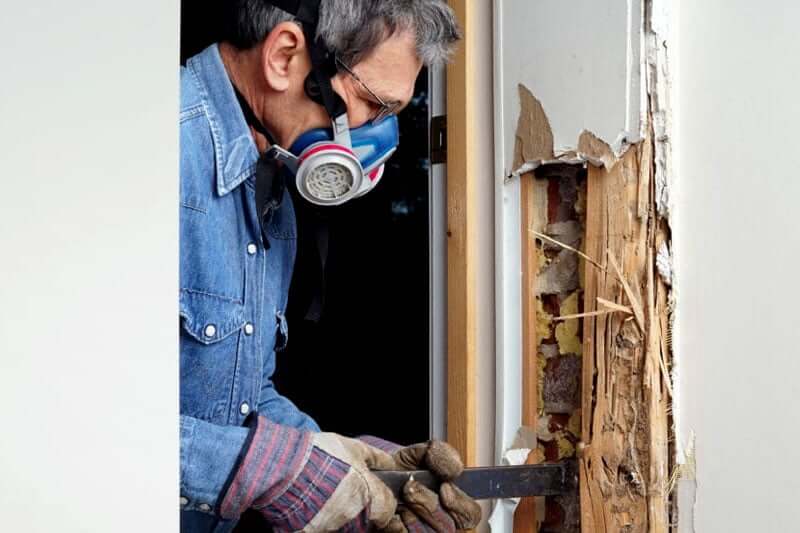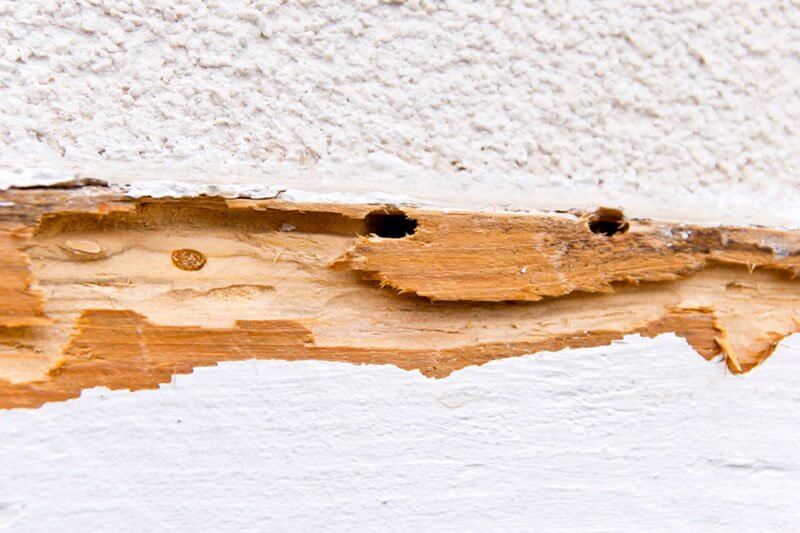You can tell that termites are in your walls by watching out for the common signs of termite infestation.
Termites are likely in your walls if there are:
- Mud tubes on your walls
- Obvious signs of peeling, cracking, or discolored paint
- Mounds of sawdust-like pellets at the foot of your walls
- Signs of warping or shifting of your walls. For example, your windows and doors become stuck for no good reason
- Visible termites crawling on your property
- Swarmers or signs of swarming – like termite wings – on your property, or
- Low clicking sounds coming from inside your walls.

Here is what you should know about signs of termites.
The following are the signs of termites and termite activity that you should look out for.
Termite mud tubes
Subterranean termites cannot exist comfortably in the open. They have thin exoskeletons that make them vulnerable to excessive moisture loss. Therefore, for them to forage for food, they need a way to protect them from moisture loss.
Their go-to solution is mud tubes. These are small tunnel-like structures that subterranean termites create. They make them out of both mud and droppings. They then condition them to have the right humidity and temperature. And the fact that these tubes also shield them from direct sunlight is an added bonus.
Therefore, if you notice tubes running from the ground and then running all over your walls, then you have a subterranean termite problem. You can even confirm that they are active by breaking off a section of the mud tube, and if you find that they have been repaired, then you have an active termite infestation on your walls.
Winged termites
When it is time to mate, winged termites leave their colonies in pairs. They do this not only to mate but also to establish new colonies.
Therefore, swarmer termites flying all over a property is usually the first giveaway that there is actually a thriving colony in a home. And so, if you notice swarming termites in your home, you should start thinking about the different ways in which you can completely remove them from your home.

Stuck doors and windows
Termites tend to target wooden structures like door and window frames because they are easily accessible. These attacks usually cause these wooden areas to warp. The resultant effect of this is often doors and windows that often get stuck or which can’t close properly.
If your windows or doors become a challenge to operate, then chances are that termites are to blame. And if they are already destroying your window and door frames to the point where they are malfunctioning, there is a likelihood that they have already invaded your walls.
Peeling or cracking paint
When termites eat through wood, they destroy its structure. This causes small shifts in the wood. And if this happens, the shifts will mess with the bond between the paint and the wood. Cracking or peeling may occur as a result.
Paint may also peel or crack because there is nothing underneath it. The termites may have chewed through all the wood to a point where the paint has nothing to hold on to.
Therefore, if the paint on your walls starts peeling or cracking, especially when this happens prematurely, it is likely a result of termite damage.
Crawling or dead termites
It is rare to see a roaming termite. They intentionally stay hidden by building their colonies underground. They also move about under the cover of mud tubes.
However, you can come across termites during a casual termite inspection. You can see them when you remove your wallpaper or rip open your walls. When moving furniture or cleaning, you can also come across a few roaming termites.
If you come across one termite in your home, the odds are that there are dry wood or subterranean termite colonies nearby. And so you should never ignore it as it is a sign of a much bigger termite problem.
Holes on walls
Termites usually go undetected because they eat walls and other wood structures from the inside. But sometimes, they run through all the guts of the structure to a point where there is nothing left.
At this point, they have no choice but to eat the wall up to the surface. This creates holes that are easily visible or that can be detected through the wallpaper. Therefore, if there are holes in your wall or on your wallpaper, termites might be to blame.
Hollow-sounding walls
When termites attack your walls, they tend to start from the center and then gradually proceed outwards. This often ends up leaving hollow walls.
Therefore, when you knock on these walls, they usually sound hollow. And so tapping your walls can help you determine whether you should be worrying about the extent of termite damage that you may have to shoulder.
Termite droppings
If you notice sawdust-like pellets at the bottom of your wall, then chances are that drywood termites are destroying your walls. This is because this is frass — -termite droppings.
Frass is usually deposited at the entrance of colonies that are created by colonies of drywood termites. This often occurs when these wood-destroying insects push their droppings out of their colonies. This makes it a clear sign of a termite infestation that needs your attention.
Wings
One of the most common signs of termite activity is the presence of wings around your home. This happens in cases where termites are swarming.
Swarmer termites usually shed their wings when mating. Therefore, if you see white wings all over your home or property, you are likely dealing with a termite infestation.
Low clicking sounds
Both drywood and subterranean termites have an elaborate system of detecting danger.
When their soldiers detect danger, they bang their heads against the wood and shake their bodies as a way of raising alarm. This usually produces a low clicking sound that can be detected when you put your head against the walls.
And so if you have been hearing sounds coming from your walls, chances are that termite activity might be to blame.
What should you do if termites are in your walls?
Once you notice the above signs of termites, you should start thinking about removing them. The problem is that termites are difficult to get rid of because they are determined, exist in large numbers, and establish their colonies underground. Therefore, the best thing you can do for your home, and before you even think about how to fix termite damage, is to seek an expert’s help.
If you need help getting rid of termites from your home, GoTreeQuotes.com offers a free service that quickly matches you with the top-voted local termite control experts in your area.
You can get 3 estimates fast by real certified experts in your area in just 2 minutes. Here is how it works.
- You scroll to the top of the page and enter your Zip code.
- Answer questions about your bed bug problem
- Your details will be forwarded to three local experts.
- You will then receive a price estimate for the job and some friendly advice.
IMPORTANT: There is no obligation to hire. This is a free tool and service to be used at your pleasure.











